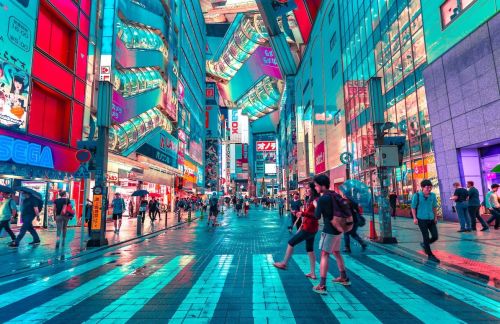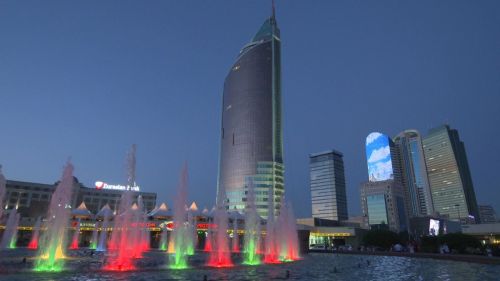Thailand is an Asian country located in its south-eastern part, famous for its interesting culture and religious architecture. This exotic country, whose history dates back to the 10th century, is dominated by the Buddhist religion. Thailand is characterized by diverse terrain, and its name comes from the name of the population - Thais, who constitute about three-quarters of the country's total population. It is a relatively well-developed country, has a warm climate, and an interesting culture that is foreign to Westerners, which makes it a very attractive tourist place, also infamously known for the so-called sex tourism.
It lies between the Indian Ocean and the Pacific Ocean. From the west, it is surrounded by the Andaman Sea (a coastal sea located in the north-eastern part of the Indian Ocean), and from the east and south by the waters of the Gulf of Thailand (formerly called the Gulf of Siam, in the western part of the Pacific Ocean).
Thailand is a constitutional monarchy, and under the 2017 constitution, the king is the head of state. Executive power is exercised by the government headed by the Prime Minister.
The state's motto is "Nation, religion, king".
It is also the largest city in Thailand, located at the mouth of the Chao Phraya River (the main river of Thailand) into the Gulf of Thailand. About 5.6 million people live there, and about 15 million in the entire agglomeration.
Bangkok is one of the world's most popular tourist destinations. In 2018, it was visited by approximately 22 million tourists - it was the most visited city in the world.
After the capital of the then Thailand (then Siam), Ayutthaya was destroyed by Burmese troops, a fortified camp was built in the place of present-day Bangkok.
In 1782, Rama I (king of Thailand from 1782 to 1809, founder of the Chakri dynasty, which still rules in Thailand today), during his coronation, gave the capital a name consisting of 43 syllables. Over the following years, 21 more syllables were added to this name, and it is currently in the Guinness Book of Records as the longest geographical name in the world.
The warmest month is April with an average daily temperature of up to 31°C. The coldest month of the year is December with an average temperature of 26°C.
There are over 400 Buddhist temples, 55 mosques (Muslims make up 6% of the population), and 10 churches (1% of the population are Christians) in the city.
The oldest Buddhist temple is Wat Pho (Temple of the Reclining Buddha) from the 16th century with a huge statue of Buddha. The next temple - Wat Traimit - has a 5.5-ton golden Buddha statue, 3 meters high.
This palace served as the official residence of the King of Thailand from the 18th to the mid-20th century. Currently, the king's residence is located in the Chitralada Royal Villa.
The Grand Palace is located on the eastern bank of the Chao Phraya River, surrounded by a defensive wall of a total length of 1900 m. The entire palace complex covers an area of 218.400 square meters.
Due to this, the city is constantly jammed and has very polluted air. To counteract this, a network of city parks was created.
Although prostitution is officially illegal in Thailand, you can meet countless prostitutes on the streets of Bangkok at night. Probably several thousand women engage in this practice.
The city offers a rich nightlife, numerous massage parlors, go-go clubs, and karaoke, thanks to which it attracts huge crowds of male tourists.
Another problem in Bangkok is the overpricing of services for tourists and pickpocketing.
It consists of two parts: the northern part (Indochina Peninsula), which is approximately 670 km wide and 830 km long, and the southern part (Malay Peninsula), approximately 880 km long and approximately 120 km wide (in the northern part, it narrows to up to 20 km).
The coastline is 3219 km long.
It is mostly a lowland country, the interior of which is occupied by the alluvial Chao Phraya Plain, stretching for 500 km. It stretches from the mountains in the north of the country to the coast of the Gulf of Thailand.
The Korat Plain occupies the eastern part of the country, its area is almost 170.000 square kilometers. From the north and east, it is bounded by the Mekong River - the longest river on the Indochinese Peninsula.
The main mountain range of Thailand is Thanon Tong Chai with the highest peak in Thailand, Doi Inthanon, with a height of 2595 m above sea level.
The coastal zone of the Malay Peninsula is occupied by lowlands, and the central part by mountains, exceeding 1000 m above sea level.
The largest of them are Phuket in the Andaman Sea and Samui and Phangan in the Gulf of Thailand.
The coastline on the west coast is rich in numerous estuaries, marshes, and cliffs. The eastern coast is flat, with few bays and extensive beaches.
Chao Phraya flows from north to south through the center of the country and flows into the Gulf of Thailand. The river delta forms numerous branches and is 200 km long and 100 km wide. The Mekong, the largest river in Southeast Asia, flows along the eastern border of Thailand.
There are many lakes in Thailand, mainly on the Korat Plain. The largest natural lake is Songkhla, with an area of 1040 square kilometers, located on the Malay Peninsula.
In the 1960s, forests covered over half of the country's area, today it is only about 30%. Teak, sandalwood, and ebony trees predominate in the monsoon forests in the central part of the country.
Large mammals are represented by Indian elephants, bantengs, and formerly also by Sumatran rhinos. The largest predators are the tigers, as well as the sun bears and the leopards.
A characteristic animal of humid forests is the Sunda flying lemur and the largest insectivorous bat - the kalong, also called the large flying fox.
The most interesting Thai bird is the white-bellied sea eagle. There are a lot of reptiles in Thailand, especially snakes, the largest representative of which is the reticulated python.
The earliest evidence of rice cultivation dates back to 2000 BC. The archaeological site of Ben Chiang in northeastern Thailand is currently the oldest known center of copper and bronze production in Southeast Asia.
The first and most powerful kingdom in Southeast Asia in the 2nd century BC was the kingdom of Funan. From the time of this kingdom until the rise of the Khmer Empire with its capital at Angkor in the 9th century, the Indochinese Peninsula was strongly influenced by Indian culture and religion.
This population reached the territory of present-day Thailand in the 10th-12th centuries. The Thais settled in the Chao Phraya basin, and assimilated with the Khmer people living there, from whom they took over their culture and religion - Buddhism.
In 1350, they established their capital in the Chao Phraya Valley - Ayutthaya, and soon this country covered the entire Indochinese Peninsula.
The state flourished in the 15th century, and in the 16th and 17th centuries, there were first contacts with Europeans (Portuguese, Spanish, Dutch, and English).
A former commander of the Ayutthai forces, Taksin took power in the country, established a new capital at Thonburi, and crowned himself king. After a palace coup, Rama I became the new king. He gave rise to a new dynasty that rules in Thailand to this day. He also moved the capital to Bangkok.
While influence, mainly French and British, was growing in the region, Siam was the only country in Southeast Asia that was never colonized by Western powers.
On June 23, 1939, the country's name was changed to Thailand.
A large percentage are Muslim Malays living mainly in the south of the country. About 2% of the population are the so-called mountain tribes, divided into about 20 groups, maintaining their customs, beliefs, and ethnic costumes.
Thais do not greet each other by shaking hands, they greet each other by bowing "Wai" with their hands folded as if in prayer. In this way, they express their respect for other people, as well as for places and objects of worship.
Buddha statues are treated with special devotion and cannot be touched, they must be shown respect.
About 40% of the country's population works in agriculture, growing rice, corn, and sugar cane.
Thailand exports its goods, mainly rice, tin, electronics, textiles, footwear, fishery products, rubber, and jewelry, primarily to Europe and North America. Exports account for over two-thirds of the country's GDP. It is Southeast Asia's second-largest economy after Indonesia and the fourth-richest country by GDP per capita, after Singapore, Brunei, and Malaysia.
Tourism plays an important role in Thailand's economy, accounting for approximately 6% of the country's economy. According to the World Tourism Organization, Thailand was the most visited country in Southeast Asia in 2013.
Thailand is the fifth largest medical tourism destination. It is popular due to the growing practice of gender reassignment surgery and plastic surgery.
Thailand is promoted as an exotic country to attract tourists. It is believed that at least 10% of tourist dollars are spent on the sex trade.
An example is Krisana Kraisintu, known as the "gypsy pharmacist", who developed one of the first fixed-dose genetic combinations of antiretroviral drugs and dedicated her life to making drugs more affordable and accessible. Her efforts saved countless lives in Africa. GPO-VIR was selected by the World Health Organization as the first treatment regimen for HIV/AIDS patients in poor countries.
In Thailand, this drug is used in the national HIV/AIDS treatment program, making it free for 100.000 patients.
The head is considered the most sacred, and the feet are the lowest part of the body. Thai customs include respect for elders and superiors (by age, position, monks, or certain professions). Part of Thai spiritual practice is respect for ancestors. Thais have a strong sense of social hierarchy, which is reflected in many honorifics. They also have a strong sense of hospitality and generosity.
Thai food combines five basic tastes: sweet, spicy, sour, bitter, and salty. The herbs and spices most commonly used in Thai cooking have medicinal properties. These include, among others, garlic, lemongrass, kaffir lime, galangal, turmeric, coriander, and coconut milk. Each region of Thailand has its specialties: green curry in the central region, green papaya salad in the northeast, khao soi in the north, and massaman curry in the south.
In 2017, seven Thai dishes were included in the list of the 50 best foods in the world.
The staple food in Thailand is rice, especially jasmine rice (also known as Mali hom), which forms part of almost every meal. Thais consume over 100 kg of rice per person per year.
Years are numbered as BE (Buddhist Era) in educational institutions, civil service, government, contracts, dates, and newspapers. However, in banking, and increasingly in industry and trade, the standard Western year counting is used.
The city of Lop Buri (Monkey City) hosts a monkey festival every November. This takes place in front of the Pra Prang Sam Yot temple. Residents prepare over 2 tons of food for the monkeys living around the temple. Thais believe that the respect they show to monkeys will ensure their success in all areas of life.












